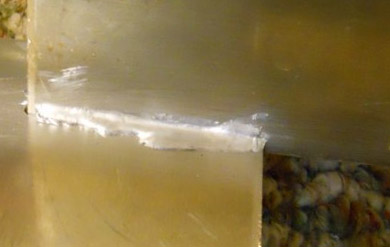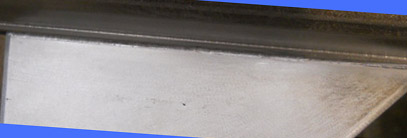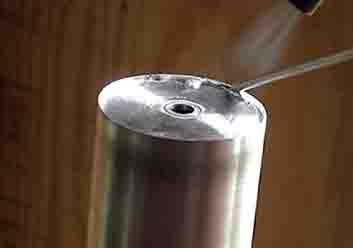Aluminum and aluminum base alloys can be soldered by techniques which are similar to those used for other metals.
Abrasion and reaction soldering are more commonly used with aluminum than with other metals. However, aluminum requires special fluxes. Rosin fluxes are not satisfactory.
Do not use solder if anything soldered come in contact with heat levels that are higher than the melting point of the solder.
Pictured: Aluminum stock with a .2″ milled slot. Area cleansed using a wire brush made out of stainless steel. Next, inserted 1/8″ aluminum. The Alumiweld Aluminum Welding Rods used requires heating the base materials to about 760°F. Once the base material is hot enough the soldering rod melts and flows into the joint.
Soldering of Aluminum Alloys
The most readily soldered aluminum alloys contain no more than 1 percent magnesium or 5 percent silicon.
Alloys containing greater amounts of these constituents have poor flux wetting characteristics. High copper and zinc-containing alloys have poor soldering characteristics because of rapid solder penetration and loss of base metal properties.
Model Rocket Fins Soldered Onto Tube
Joint Design
The joint designs used for soldering aluminum assemblies are similar to those used with other metals. The most commonly used designs are forms of simple lap and T-type joints.
Joint clearance varies with the specific soldering method, base alloy composition, solder composition, joint design, and flux composition employed. However, as a guide, joint clearance ranging from 0.005 to 0.020 in. (0.13 to 0.51 mm) is required when chemical fluxes are used. A 0.002 to 0.010 in. (0.05 to 0.25 mm) spacing is used when a reaction type flux is used.
Joints must fit snugly, but not so snug that the solder cannot get into the gap.
Preparation
Grease, dirt, and other foreign material must be removed from the surface of aluminum before soldering.
The surface must be clean. A stainless steel brush or steel wool works well. In most cases, only solvent degreasing is required. However, if the surface is heavily oxidized, wire-brushing or chemical cleaning may be required.
CAUTION
Caustic soda or cleaners with a pH above 10 should not be used on aluminum or aluminum alloys, as they may react chemically.
Area prepared with a stainless steel wire brush to remove any grease or oil. Blowtorch used to heat base metal first followed by melting Harbor Freight Alumiweld Aluminum Welding Rods.
Soldering Techniques
The higher melting point solders normally used to join aluminum assemblies plus the excellent thermal conductivity of aluminum dictate that a large capacity heat source must be used to bring the joint area to proper soldering temperature. Uniform, well-controlled heating should be provided.
Tinning of the aluminum surface can best be accomplished by covering the material with a molten puddle of solder and then scrubbing the surface with a non-heat absorbing item such as a glass fiber brush, serrated wooden stick or fiber block. Wire brush or other metallic substances are not recommended. They tend to leave metallic deposits, absorb heat, and quickly freeze the solder.
Solders
The commercial solders for aluminum can be classified into three general groups according to their melting points:
- Low temperature solders. The melting point of these solders is between 300 and 500ºF (149 and 260ºC). Solders in this group contain tin, lead, zinc, and/or cadmium and produce joints with the least corrosion resistance.
- Intermediate temperature solders. These solders melt between 500 and 700 ºF (260 and 371ºC). Solders in this group contain tin or cadmium in various combinations with zinc, plus small amounts of aluminum, copper, nickel or silver, and lead.
- High temperature solders. These solders melt between 700 and 800ºF (371 and 427ºC). These zinc base solders contain 3 to 10 percent aluminum and small amounts of other metals such as copper, silver, nickel; and iron to modify their melting and wetting characteristics. The high zinc solders have the highest strength of the aluminum solders, and form the most corrosion-resistant soldered assemblies.
Rules of Aluminum Soldering
- Before starting any aluminum soldering project, clean the metal to remove grease and oils
- Joint fit must be snug but with a gap for the solder
- Don’t let the parts move while soldering, this will result in a poor result
- Review the manufacturers instructions for the right amount of heat
- Use the correct flux.


